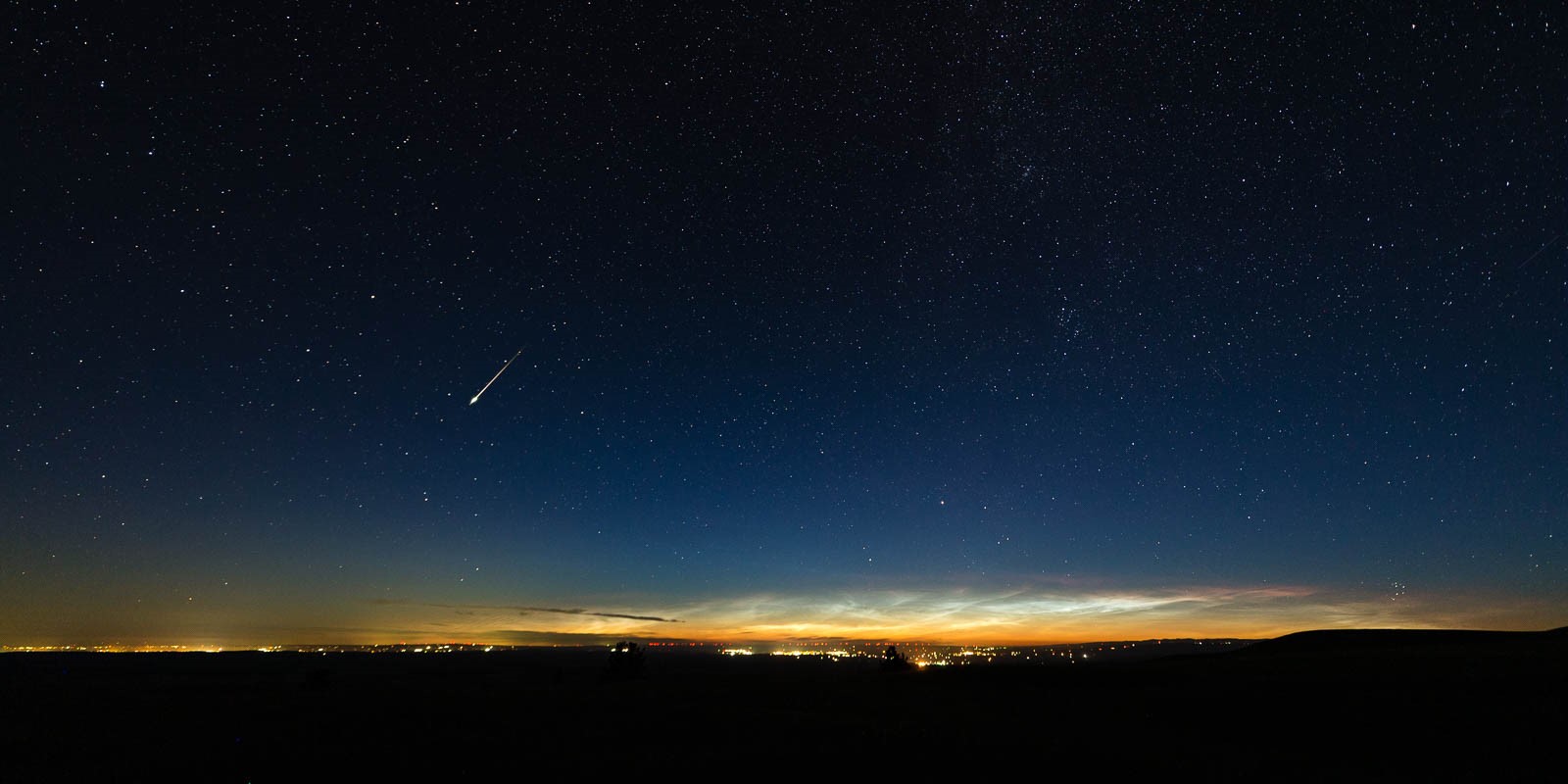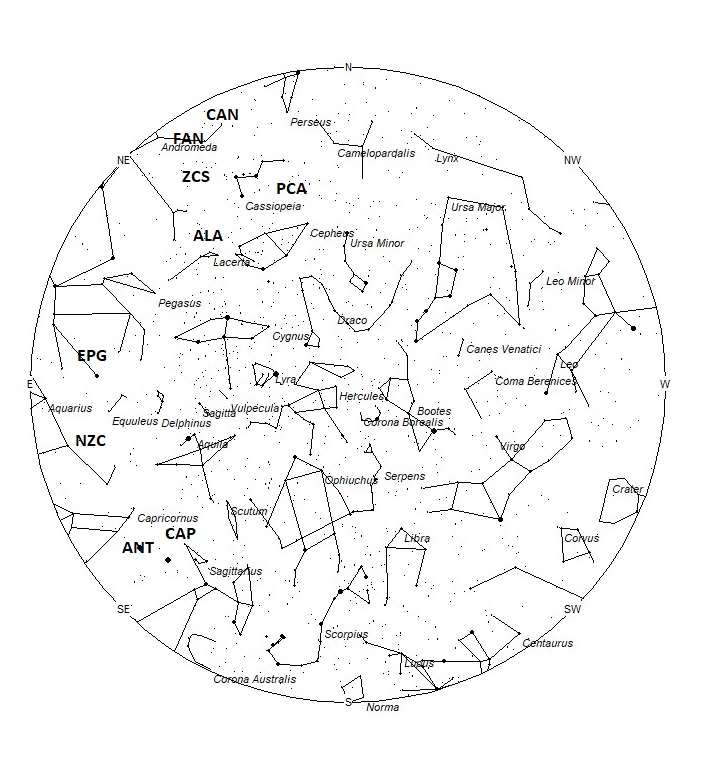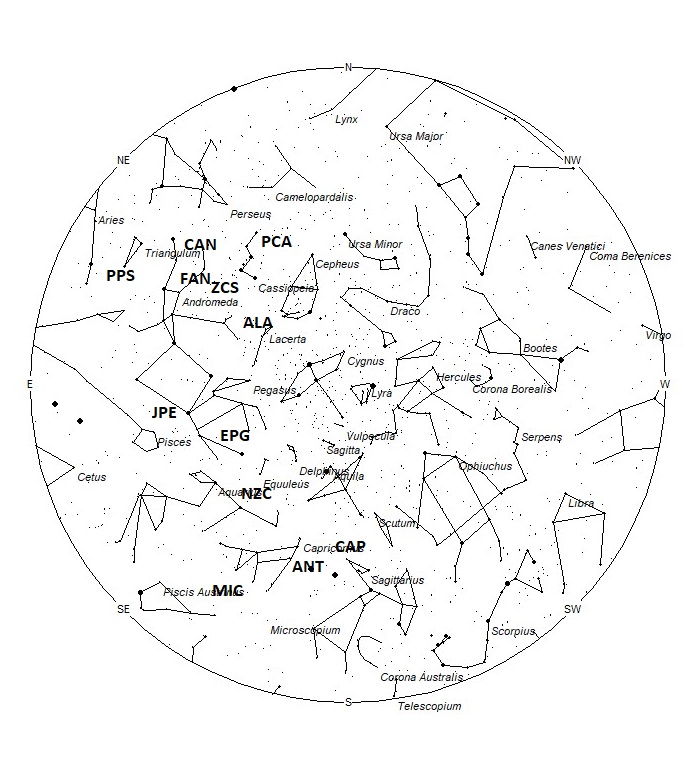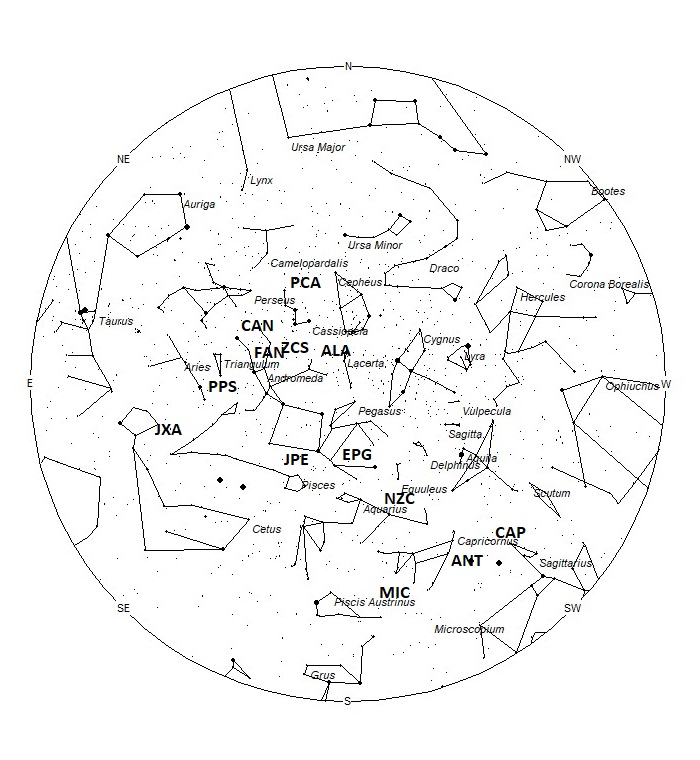
During this period, the moon reaches its last quarter phase on Monday July 13th. At this time, the moon is located 90 degrees west of the sun and rises near 0100 local daylight saving time (LDST). As the week progresses the waning crescent moon rises later in the morning with each passing night. This allows the window of dark skies to increase as the week progresses. The most active hours just prior to dawn will have slight interference from moonlight but one can overcome this simply facing in a direction where the moon is not visible within your field of view. The estimated total hourly meteor rates for evening observers this week is near 3 for those viewing from the southern hemisphere and 2 for those located north of the equator. For morning observers, the estimated total hourly rates should be near 13 as seen from tropical southern locations (25S) and 14 as seen from mid-northern latitudes (45N). The actual rates will also depend on factors such as personal light and motion perception, local weather conditions, alertness, and experience in watching meteor activity. Morning rates are reduced during this period due to moonlight. Note that the hourly rates listed below are estimates as viewed from dark sky sites away from urban light sources. Observers viewing from urban areas will see less activity as only the brighter meteors will be visible from such locations.
The radiant (the area of the sky where meteors appear to shoot from) positions and rates listed below are exact for Saturday night/Sunday morning July 11/12. These positions do not change greatly day to day so the listed coordinates may be used during this entire period. Most star atlases (available at science stores and planetariums) will provide maps with grid lines of the celestial coordinates so that you may find out exactly where these positions are located in the sky. A planisphere or computer planetarium program is also useful in showing the sky at any time of night on any date of the year. Activity from each radiant is best seen when it is positioned highest in the sky, either due north or south along the meridian, depending on your latitude. It must be remembered that meteor activity is rarely seen at the radiant position. Rather they shoot outwards from the radiant, so it is best to center your field of view so that the radiant lies at the edge and not the center. Viewing there will allow you to easily trace the path of each meteor back to the radiant (if it is a shower member) or in another direction if it is a sporadic. Meteor activity is not seen from radiants that are located far below the horizon. The positions below are listed in a west to east manner in order of right ascension (celestial longitude). The positions listed first are located further west therefore are accessible earlier in the night while those listed further down the list rise later in the night.
These sources of meteoric activity are expected to be active this week.
.
The alpha Capricornids (CAP) are active from July 2 through August 10 with maximum activity occurring during the last week of July. The broad maximum occurs anywhere from July 25 to the 30th with visual rates usually around 3 per hour. The radiant is currently located at 19:12 (288) -14, which places it in northeastern Sagittarius, 5 degrees northwest of the 4th magnitude star known as rho1 Sagittarii. This radiant is best placed near 0100 LDST when it lies on the meridian and is located highest in the sky. Hourly rates at this time should be near 1 no matter your location. With an entry velocity of 22 km/sec., the average alpha Cap meteor would be of slow velocity.
The center of the large Anthelion (ANT) radiant is currently located at 20:08 (302) -20. This position lies on the Sagittarius/Capricornus border, close to the position occupied by the zero magnitude planet Saturn. Due to the large size of this radiant, anthelion activity may also appear from western Capricornus as well as eastern Sagittarius. This radiant is best placed near 0200 LDST, when it lies on the meridian and is located highest in the sky. Rates at this time should be near 2 per hour as seen from mid-northern latitudes (45 N) and 3 per hour as seen from the southern tropics (S 25). With an entry velocity of 30 km/sec., the average anthelion meteor would be of slow velocity.
The Northern June Aquilids (NZC) are active from a radiant located at 21:13 (318) -03. This area of the sky is located in western Aquarius, 4 degrees northwest of the 3rd magnitude star known as Sadalsuud (beta Aquarii A). This radiant is best placed near 0300 LDST, when it lies on the meridian and is located highest in the sky. Hourly rates at this time should be near 1 no matter your location. With an entry velocity of 38 km/sec., the average meteor from this source would be of medium-slow velocity. An interesting fact about this source is that it may be related to the August beta Piscids (Northern delta Aquariids) of August. Where and when this source ends coincides with the start and position of the August beta Piscids.
The Microscopiids (MIC) were discovered by G. Gartrell and W. G. Elford, in their study of Southern Hemisphere meteor streams. This stream is active from June 9 through July 17 with maximum activity occurring on July 5. The radiant is currently located at 21:42 (326) -26. This area of the sky is actually located in northwestern Piscis Austrinus, 3 degrees northwest of the dim star known as eta Piscis Austrini. This radiant is best placed near 0400 LDST, when it lies on the meridian and is located highest in the sky. Hourly rates at this time are expected to be near 1 as seen from the northern hemisphere and 2 as seen from south of the equator. With an entry velocity of 39 km/sec., the average meteor from this source would be of medium-slow velocity. This source is synonymous with the Southern June Aquilids (SZC).
The epsilon Pegasids (EPG) were discovered by Dr. Peter Brown and associates using data from the Canadian Meteor Orbit Radar (CMOR) installation. These meteors are active from July 03-23 with maximum activity occurring on July 11th. The radiant position currently lies at 22:04 (331) +13. This area of the sky lies in western Pegasus, 5 degrees northeast of the 2nd magnitude star known as Enif (epsilon Pegasi). These meteors are best seen near 0400 LDST when the radiant lies highest in the sky. Hourly rates are expected to be less than 1 no matter your location. With an entry velocity of 28 kilometers per second, most of these meteors will appear to move with medium-slow velocities. Being discovered by radar, a majority of these meteors may be dim and difficult to see.
The alpha Lacertids (ALA) were also discovered by Dr. Peter Brown and associates using data from the Canadian Meteor Orbit Radar (CMOR) installation. These meteors are active from July 01-23 with maximum activity occurring on July 11th. The radiant position currently lies at 23:16 (349) +52. This area of the sky lies in northwestern Andromeda, 6 degrees east of the 4th magnitude star known as alpha Lacertae. These meteors are best seen near 0500 LDST when the radiant lies highest in the sky. Hourly rates are expected to be less than 1 no matter your location. With an entry velocity of 37 kilometers per second, most of these meteors will appear to move with medium velocities. Being discovered by radar, a majority of these meteors may be dim and difficult to see.
The July Pegasids (JPE) are active during the entire month of July with maximum activity occurring on July 10th. The radiant is currently located at 23:18 (350) +12. This area of the sky is located in southern Pegasus, 4 degrees southeast of the 2nd magnitude star known as Markab (alpha Pegasi). This radiant is best placed near 0500 LDST, when it lies on the meridian and is located highest in the sky. Rates are expected to be near 1 per hour this week no matter your location. With an entry velocity of 68 km/sec., the average meteor from this source would be of swift velocity.
The zeta Cassiopeiids (ZCS) were discovered Przemysław Zoładek and Mariusz Wisniewski during a Polish meteor workshop in 2005 and also by members of the Croatian Meteor Network. These meteors are active from July 2-27 with maximum activity occurring on July 15. The current position of the radiant is 00:20 (005) +50. This position lies in a southern Cassiopeia, 8 degrees southwest of the 2nd magnitude star known as Schedar (alpha Casssiopeiae). Rates are currently expected to be less than 1 per hour no matter your location. These meteors are best seen near during the last dark hour of the night when the radiant lies highest in a dark sky. With an entry velocity of 57 km/sec., the average zeta Cassiopeiid meteor would be of swift speed.
The 49 Andromedids (FAN) were discovered by Željko Andreić and the Croatian Meteor Network team based on studying SonotaCo and CMN observations (SonotaCo 2007-2011, CMN 2007-2010). These meteors are active from July 5 through August 13 with maximum activity occurring on July 20. The current position of the radiant is 01:07 (017) +45. This position lies in northern Andromeda, 4 degrees south of the 4th magnitude star known as phi Andromedae. Rates are currently expected to be less than 1 per hour no matter your location. These meteors are best seen near during the last dark hour of the night when the radiant lies highest in a dark sky. With an entry velocity of 60 km/sec., the average meteor from this source would be of swift speed.
The psi Cassiopeiids (PCA) were discovered by Zdenek Sekanina in his study of radio streams. These meteors are active from July 4 through August 7 with maximum activity occurring on July 21. The current position of the radiant is 01:20 (020) +70. This position lies in a remote area of northern Cassiopeia. The easiest way to pinpoint this radiant to go 40% of the way between the stars gamma Cassiopeiae and gamma Cephei (for more help refer to the charts provided). Rates are currently expected to be less than 1 per hour no matter your location. These meteors are best seen near during the last dark hour of the night when the radiant lies highest in a dark sky. With an entry velocity of 42 km/sec., the average psi Cassiopeiid meteor would be of medium speed. Being discovered by radio, a majority of these meteors may be dim and difficult to see.
The phi Piscids (PPS) were another discovery by Dr. Peter Brown and associates using data from the Canadian Meteor Orbit Radar (CMOR) installation. These meteors are active from June 8-August 02 with maximum activity occurring on July 4th. The radiant position currently lies at 01:39 (025) +28. This area of the sky lies in northeastern Pisces, 3 degrees southwest of the 3rd magnitude star known as Mothallah (alpha Trianguli). These meteors are best seen near during the last dark hour of the night when the radiant lies highest in a dark sky. Current rates should be near 1 per hour as seen from the northern hemisphere and less than 1 as seen from south of the equator. With an entry velocity of 67 kilometers per second, most of these meteors will appear to move with swift velocities. Being discovered by radio, a majority of these meteors may be dim and difficult to see.
The c-Andromedids (CAN) were discovered by Sirko Molau and Juergen Rendtel using video data from the IMO network. Activity from this source is seen from June 25 through July 26 with maximum activity occurring on July 9. The radiant currently lies at 02:08 (032) +49, which places it in southwestern Perseus, 4 degrees east of the 4th magnitude star known as Nembus (51 Andromedae). This area of the sky is best seen during the last dark hour before dawn when the radiant lies highest in a dark sky. Observers in the northern hemisphere are better situated to view this activity as the radiant rises much higher in the sky before dawn compared to southern latitudes. Current rates should be near 1 per hour for observers in the northern hemisphere and less than 1 for observers in the southern hemisphere. With an entry velocity of 58 km/sec., the average meteor from this source would be of swift velocity.
The July chi Arietids (JXA) were discovered by two investigating teams in Europe using video data from European video Meteor Network Database (EDMOND), SonotaCo, 2013; and CMN, 2013. Activity from this stream is seen from July 2 through August 1 with maximum activity occurring on July 13. The radiant currently lies at 02:18 (034) +09, which places it in northeastern Cetus, directly between the two 4th magnitude stars known as Xi1 and Xi2 Ceti. This area of the sky is best seen during the last dark hour before dawn when the radiant lies highest in a dark sky. Current rates are expected to be near 1 per hour as seen from the northern hemisphere and less than 1 as seen from south of the equator. With an entry velocity of 69 km/sec., the average meteor from this source would be of swift velocity.
Sporadic rates have evened out at this time with morning rates near 6 per hour and evening rates near 3 no matter your location. Morning rates are reduced during this period due to moonlight.
The list below offers the information from above in tabular form. Rates and positions are exact for Saturday night/Sunday morning except where noted in the shower descriptions.
| SHOWER | DATE OF MAXIMUM ACTIVITY | CELESTIAL POSITION | ENTRY VELOCITY | CULMINATION | HOURLY RATE | CLASS |
| RA (RA in Deg.) DEC | Km/Sec | Local Summer Time | North-South | |||
| alpha Capricornids (CAP) | Jul 26 | 19:12 (288) -14 | 22 | 01:00 | 1 – 1 | II |
| Anthelion (ANT) | – | 20:08 (302) -20 | 30 | 02:00 | 2 – 3 | II |
| Northern June Aquilids (NZC) | Jul 02 | 21:13 (318) -03 | 41 | 03:00 | 1 – 1 | IV |
| Microscopiids (MIC) | Jul 05 | 21:42 (326) -26 | 39 | 04:00 | 1 – 2 | IV |
| epsilon Pegasids (EPG) | Jul 11 | 22:04 (331) +13 | 28 | 04:00 | <1 – <1 | IV |
| alpha Lacertids (ALA) | Jul 11 | 23:16 (349) +52 | 37 | 05:00 | <1 – <1 | IV |
| July Pegasids (JPE) | Jul 10 | 23:18 (350) +12 | 68 | 05:00 | <1 – <1 | IV |
| zeta Cassiopeiids (ZCS) | Jul 15 | 00:20 (005) +50 | 57 | 06:00 | <1 – <1 | IV |
| 49 Andromedids (FAN) | Jul 20 | 01:07 (017) +45 | 60 | 07:00 | <1 – <1 | IV |
| psi Cassiopeiids (PCA) | Jul 21 | 01:20 (020) +70 | 42 | 07:00 | <1 – <1 | IV |
| phi Piscids (PPS) | Jul 04 | 01:39 (025) +28 | 67 | 07:00 | 1 – <1 | IV |
| c-Andromedids (CAN) | Jul 09 | 02:08 (032) +49 | 58 | 08:00 | 1 – <1 | IV |
| July chi Arietids (JXA) | Jul 13 | 02:18 (034) +09 | 69 | 08:00 | 1 – <1 | IV |
 American Meteor Society
American Meteor Society


